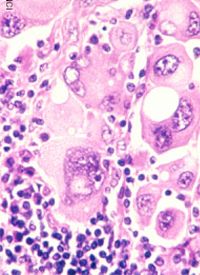Dabrafenib Shows Remarkable Intracranial Activity in Patients With BRAF-Mutant Melanoma and Brain Metastases
Monotherapy with potent BRAF inhibitor dabrafenib (Tafinlar) resulted in a disease control rate of 83% in patients with BRAF-mutant melanoma and brain metastases.
Melanoma

Monotherapy with potent BRAF inhibitor dabrafenib (Tafinlar) resulted in a disease control rate of 83% in patients with BRAF-mutant melanoma and brain metastases, according to a retrospective study presented during the 7th European Post-Chicago Melanoma/Skin Cancer Meeting, which took place June 29 to 30 in Munich, Germany.1
A single-center, controlled retrospective study was performed in Hungary between 2014 and 2017 looking at 30 patients with advanced BRAF-mutant melanoma and brain metastases. Patients in the retrospective part of the study received dabrafenib following local control of brain metastases. The control arm of the study comprised 204 melanoma patients with brain metastases from a melanoma database in Budapest, all of whom were treated with local therapies and/or chemotherapy between 2003 and 2015.
Patients in the retrospective group had a median age of 59.2 years (range, 21.8-75.1) and were evenly divided by gender. Patients had an ECOG performance status (PS) of 0 to 2, including 27% with a PS of 0, and 40% with a PS of 1.
The median tumor Breslow depth was 3.9 mm (range, 0.7-21.0). More than half of patients (57%) had elevated lactate dehydrogenase (LDH) levels at baseline and almost three-quarters had more than 2 brain metastases (70%). Similar proportions of patients had 1 or 2 brain metastases (17% and 13%, respectively). Twenty-one patients (70%) had 2 or fewer extracranial organs with metastases. A majority of patients had a BRAF V600E mutation (83%).
Previous therapies included surgical resection (30%), stereotactic radiosurgery (33%), whole-brain radiotherapy (53%), chemotherapy (20%), and vemurafenib (Zelboraf) therapy (7%).
Baseline characteristics appeared to be similar between the study and control groups. In the control group, the median age was 56.7 years (range, 21.0-83.1). There were more males than females (64% vs 36%, respectively) and like in the study arm, the majority of patients had an ECOG PS of 1 (51%). Slightly more patients had a PS of 2 (29%), compared with the study arm and 41 patients (20%) had a PS of 0.
Fewer patients in the control group had more than two brain metastases (45%), compared with the study group. Approximately one-third of patients had only 1 metastatic brain lesion and 40 patients (20%) had 2 brain metastases. Eighty-three percent of patients in the control arm had no more than 2 extracranial organs with metastatic involvement.
With respect to previous therapy, 90 patients (44%) in the control group had undergone resection, 88 (43%) had undergone stereotactic radiosurgery, 145 (71%) had undergone whole-brain radiotherapy, and 149 (73%) had received chemotherapy.
In the retrospective arm, 4 patients (13%) experienced a complete response, 9 (30%) had partial responses, and 12 (40%) had stable disease. After a median follow-up of 14 months, the median progression-free survival was 5.5 months, and the median overall survival (OS) was 8.8 months.
When calculated from the onset of brain metastases, the median OS was significantly longer in the study group compared with controls (11.8 vs 6.0 months, respectively; HR, 0.45; P = .0014).
Study author Kata Czirbesz, MD, from the National Institute of Oncology in Budapest, Hungary, told OncLive that “in addition to the intracranial response rate, 27% of patients had an ECOG PS of 2 and the prognosis for these patients is usually pretty dismal. So, I think, in this study population, this is a very good result.”
However, patients with a higher ECOG performance status were still at a significantly higher risk of progression (HR, 4.06; P = .00027) as were patients with involvement in more than 2 extracranial organs (HR, 3.4; P = .0077). In addition, patients with elevated LDH levels at baseline tended to have a worse clinical outcome; however, this finding was nonsignificant.
Dabrafenib has also shown intracranial activity in previous clinical studies, such as in the phase II BREAK-MB study of melanoma patients with brain metastases.2 In patients with untreated brain metastases the intracranial disease control rate was 80% to 90% in patients with BRAF V600E-mutant melanoma and 50% in patients with a V600K mutation. Activity was also seen in patients with previously treated and progressed brain metastases.
The investigators of the retrospective analysis concluded that their study confirms dabrafenib’s “remarkable” intracranial activity as observed in real-world practice.
References
- 1) Gorka E, Fabó D, Gézsi A, et al. Dabrafenib therapy in 30 patients with melanoma metastatic to the brain: a single-centre controlled retrospective study in Hungary. Poster presented at: 7th European Post-Chicago Melanoma/Skin Cancer Meeting; June 29-30, 2017; Munich, Germany. Abstract 3.
- 1) Long GV, Trefzer U, Davies MA, et al. Dabrafenib in patients with Val600Glu or Val600Lys BRAF-mutant melanoma metastatic to the brain (BREAK-MB): a multicentre, open-label, phase 2 trial. Lancet Oncol. 2012;13(11):1087-1095. doi: 10.1016/S1470-2045(12)70431-X.
<<<



